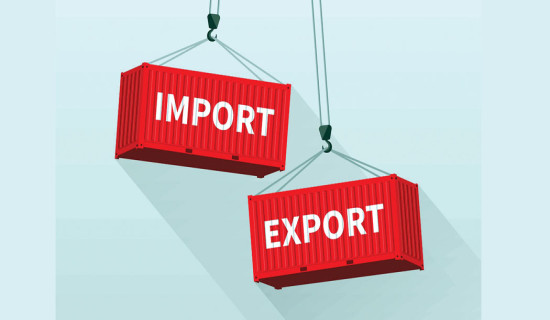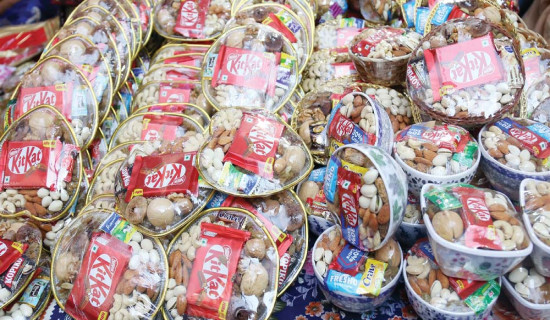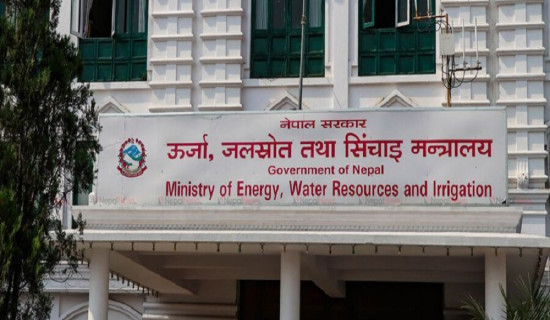- Sunday, 9 November 2025
Double-digit growth in exports in first five months of FY
Nepal's exports have recorded a double-digit growth in the first five months of the current fiscal year. According to the trade statistics made public by the Department of Customs on Sunday, goods worth Rs. 73.65 billion were exported during the first five months (mid-November to mid-December) of the current fiscal year 2024/25.
Private sector to construct power transmission line for first time
For the first time, the private sector has entered the construction of transmission lines for domestic power supply. The Tamor-Dhungesangh
Paddy production likely to set new record this year
Paddy production is likely to increase further this year and set a new record. According to a prelimina
Foreign reserves sustain steady growth
Nepal’s foreign currency reserves have witnessed a significant increase in the first four months of the current fiscal year. According to the current
Over one million tourists visit in 11 months
Tourist arrivals have crossed the milestone of one million in the first 11 months of the year 2024. With 114,501 tourists visiting in November, Nepal welcomed 1,055,533 foreign tourists by November this year, according to Nepal Tourism Board (NTB). This is 5.40 per cent higher than the tourist arrivals during the same month of the last fiscal year 2023. But it is only 87.87 per cent of tourists who landed in Nepal in 2019
Hotels multiply, raising hopes for tourism industry, national economy
Nepal’s tourism and hospitality industry has seen a remarkable expansion in recent years, with the establishment of significant number of luxury accommodations, including five-star hotels.
Gold price down by Rs. 15,900 per tola as govt cuts customs duty
After the government reduced the customs duty for the precious metal, the price of gold has plummeted in the domestic market on Monday. In a significant single-day decline, the price of gold fell by Rs. 15,900 per tola following the Cabinet's decision to slash the customs duty on gold.
Nepal starts exporting electricity to Bangladesh
In a significant development for regional energy cooperation, Nepal has officially begun exporting electricity to Bangladesh. The export of 40 megawatts of electricity produced in Nepal to Bangladesh began on Friday.
Soaring dry fruit prices compel consumers to curtail quantity
As the Tihar festival descends upon us, a significant concern has distressed consumers in Nepal: the soaring prices of dry fruits. The consumption of dry fruits hits the peak in Tihar festival as women offer these delicacies to their brothers during the Bhai Tika festival. However, this year, many are finding it increasingly difficult to afford these requisite items due to sharp price hikes.
Glow lights business dims down this Tihar
People are now preparing to celebrate Tihar, also known as the festival of flowers and lights. Clay palas, electric lights
Tomatoes too dear for ordinary consumers
The price of tomatoes has skyrocketed in the Kathmandu Valley over the past few weeks. Local shopkeepers cite short supply for the high prices. According to the Kalimati Fruit and Vegetable Market Development Board (KFVMDB), the wholesale price of tomatoes, one of the most essential vegetables, jumped up to Rs. 150 per kilogram on Saturday while it was only Rs. 50 a month ago.
88 MW power added to national transmission grid in 100 days
Additional 88 megawatts of electricity has been added to the national grid during the first three months of the current fiscal year 2024/25. Presenting the 100-day work progress of the Ministry of Energ
Electricity worth Rs. 7.5 billion exported to India in two months
Electricity worth Rs. 7.54 billion has been exported to India during the first two months of the current fiscal year. Nepal Electricity Author
Disasters cause damage worth Rs. 4.3bn in energy, irrigation sectors
Due to continuous rain for two days, floods and landslides across the country have caused losses of approximately Rs. 4.35 billion in the energy and irrigation sectors. According to preliminary r
Upper Tamakoshi, several other hydro projects hampered by rains, floods
Several hydropower projects across the country have been affected due to floods in rivers in the wake of heavy rains. According to the Nepal Electricity

















